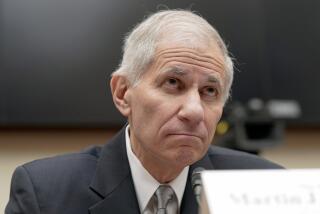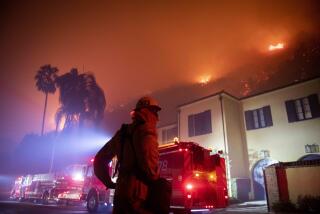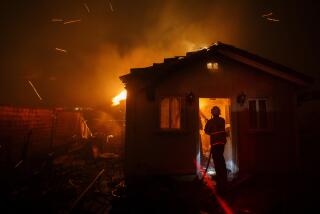FDIC bank insurance fund shrinking; official says deposits are safe
- Share via
WASHINGTON AND ORANGE COUNTY — Today is Failure Friday, the grim point each week when federal regulators typically seize the latest round of most-troubled banks. Expect more bad news in the Fridays to come, even though the economy shows signs of improving.
U.S. banks lost a combined $3.7 billion in the second quarter, and the 81 failures this year have reduced the federal fund that insures deposits to its lowest level since 1993, when the fiasco in the savings and loan industry was drawing to a close.
Some analysts speculate that the Federal Deposit Insurance Corp. will have to tap its $500-billion line of credit or, worse, seek taxpayer money to cover expected future losses. Regardless of where the agency gets the rescue money, its chairwoman sought Thursday to reassure Americans that their deposits were in no danger.
“The FDIC was created specifically for times such as these,” Sheila C. Bair said. “Our resources are strong. Your insured deposits are safe.”
But that doesn’t mean your bank is safe.
The FDIC has opened a facility in Irvine where more than 400 employees, most of them newly hired, plan to work for three to five years closing banks in the western United States and disposing of their bad assets. The offices are in a 15-story tower that had sat empty since developer Irvine Co. completed it last year as part of the Irvine Spectrum complex.
Bair warned of many more failures as banks move beyond the housing collapse to deal with problems caused by troubles in the commercial real estate market and the continued effect of high unemployment. That will keep regulators busy Friday evenings, a time they prefer for taking down failed institutions so they have the weekend to usher in new management and get branches ready to reopen Mondays.
“Loans are going bad because people are losing their jobs or their businesses are closing down, or people aren’t traveling and staying in hotels,” Bair said.
“Banks typically are a lagging indicator, so even as the economy rebounds, you’ll probably still see a continuing increase in bank failures.”
James Chessen, chief economist for the American Bankers Assn., said that banks “are neither at the beginning nor the end of the problems presented by a difficult economy. They are in the middle, and significant challenges still remain.”
He stressed that 96% of banks were deemed “well capitalized” by regulators.
But the FDIC has estimated that bank failures now through 2013 could cost its insurance fund about $65 billion.
Many of those failures will come from banks the FDIC has identified as “problem institutions.” That figure continues to swell -- to 416 in the second quarter from 305 in the first. It is the largest number of banks in danger of failing since 1994.
Those problem institutions, which the FDIC does not publicly identify for fear depositors would rush to take out their money, had a total of $300 billion in assets.
The amount of expected losses is troubling because the insurance fund, which covers accounts up to $250,000, has been depleted badly by earlier bank failures.
The fund’s balance plunged 20% in the second quarter to $10.4 billion. That was its lowest level since 1993 and came before 36 more banks collapsed this summer. At the end of June last year, the fund had $45.2 billion.
To avoid tapping into its line of credit at the U.S. Treasury, the FDIC this year raised the assessments it charges banks to furnish the insurance backstop. Banks pay about $12 billion a year in premiums, and the increased assessments added nearly $6 billion in the second quarter.
Bair said the fund was in better shape than it appeared. The FDIC has set aside an additional $32 billion to cover losses at banks expected to fail over the next year, she said. For example, the failure of Colonial Bank in Montgomery, Ala., this month was estimated to cost the FDIC $2.8 billion, but the loss was anticipated as part of money set aside for future failures and did not reduce the fund’s level.
Not all banks on the problem list fail. And when they do, they still have assets the FDIC can sell to cover some of the insured deposits. The 45 banks that failed through June 30 this year had a total of $35.9 billion in assets but are estimated to cost the insurance fund $10.5 billion.
The agency now has $43.2 billion in assets from failed institutions that it is trying to sell.
Though the FDIC can draw on its line of credit to cover shortfalls, as it did once before during the S&L; crisis, Bair said she did not anticipate needing to borrow any money.
The FDIC, however, has said it expects to levy another special assessment on banks by the end of September to help replenish the fund.
Richard Newsom, a former FDIC bank examiner, said that Bair is “delusional if she actually thinks additional bank fees and assessments will cover the black hole in the FDIC insurance fund.”
Newsom blamed the FDIC and other regulators for contributing to the industry’s downfall by easing up on oversight earlier this decade.
“I am certain the published numbers of problem banks and related dollars dramatically understate the actual number and dollar amount of problem institutions in the banking system, as it has for at least two years,” he said.
“ ‘Too big to fail’ historically means too big to put on the problem list and admit to past regulatory failure,” he said.
Executives at healthy banks have been chafing at the prospect of ponying up more money to cover the growing losses from failed institutions.
The FDIC is trying to be creative in how it sells the assets of seized banks to lessen the effect on the insurance fund. On Wednesday, the agency’s board eased proposed rules on private equity firms seeking to buy failed banks. And the agency has entered into agreements to limit the exposure of buyers to failed banks’ loan losses.
As bleak as things look, they aren’t expected to reach the levels of the S&L; crisis -- at least in the sheer number of failures. There were 1,043 failures then, compared with 106 since this recession began in late 2007. But banks are larger now, and the $408 billion in assets of the latest crop of failures is approaching the $519 billion in assets of the earlier banking crisis.
“There will be more bank failures this year and next, but it’s still going to be a small percentage of banks overall,” Bair said. “But there are a lot of losses to work through.”
--
jim.puzzanghera @latimes.com
More to Read
Inside the business of entertainment
The Wide Shot brings you news, analysis and insights on everything from streaming wars to production — and what it all means for the future.
You may occasionally receive promotional content from the Los Angeles Times.









